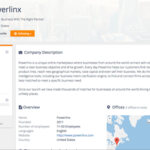Match Me if You Can: The Story of the Powerlinx Matching Engine
As we previously reported, nearly half of business leaders believe their company is not very good at building successful partnerships. It seems existing methods for sourcing new partnerships are not as effective as business leaders would like them to be.
At Powerlinx, we believe there’s a better way to find new partners – and we’re using a combination of “smart” technology and the power of the Internet to build it.
Today we rely on the Internet for a multitude of business tasks: browsing the news and items of interest, research, email, e-commerce and much more. But strangely enough when it comes to finding new sources of business opportunities the Internet’s vast potential is hardly tapped because there are no automated tools available. If we can automate almost every other aspect of our business lives, why aren’t we automating the processes we use to find new business partnerships? This is the opportunity that the Powerlinx matching platform aims to fill through our proprietary “matching engine.” In this post, I’ll explain why this matching engine is needed and how it makes Powerlinx so special.
Why Existing Search Engines Don’t Cut It
I’ll start by admitting the techniques and vehicles we can use for finding suitable business partners have indeed been dramatically enhanced through technology. On a basic level, the vast amount of information we cull from the Internet has significantly expanded the breadth and depth of compiled business databases, allowing for far more complex and diversified searches. On top of this, newer technologies now allow us to both compile lists of tens of thousands of companies and efficiently filter them for the few that interest us most. Finally, social networks like LinkedIn provide us with an easy way to instantly connect with people who run businesses around the world.
Although we’ve become accustomed to using the above techniques, they do have significant limitations. Here are just a few examples:
- Current business databases might not be user-friendly or support user needs. Let’s say, for example, a company is searching for a manufacturer of lithium batteries. In this case, a database of businesses coded in SIC or NAICS industries wouldn’t come close enough to satisfy the company’s criteria.
- Users might not know how to properly phrase what they are looking for. For example, how should a women’s fashion jewelry manufacturer describe a target market for sales expansion?
- Searching business databases for exact phrases leads to limited results. For example, searching for a term like “outdoor furniture manufacturers with more than 20 employees” might produce only a handful of companies, if any. Today’s search engines are missing the give and take that allows for high quality, but not limited, results.
- Business database search results produce an unranked list of companies, forcing users to manually research each result and rank them themselves, which is an extremely time-consuming process.
When we started formulating ideas for the Powerlinx matching engine, we aimed to develop a business partner matching system that would help business leaders easily find the suppliers, manufacturers and other potential partners they were looking for – without the limitations stated above. To start, we decided to focus on SMBs and spent significant time researching the way they grow and what such business owners would like to experience.
We saw that, broadly, SMBs used two paths to source new opportunities: fee-based professional business consultants and lower-cost self-directed efforts, including personal networking. We noticed that both of these paths operate through starkly different methods. On the one hand, consultants start the matching process by examining the fundamentals of a business and its needs: what a business is trying to achieve, its current state of affairs and its market conditions. Consultants only make recommendations after receiving, clarifying and digesting a lot of information. In stark contrast, self-directed efforts such as purchased lists or social networking connections jump to the target market without much probing about goals and the environment.
Not surprisingly, our findings from studying SMBs, corroborated by custom market research, showed us that consultants typically provided much better results. This is why we modeled Powerlinx after the way business consultants act – but in an automated, high quality way.
Automating the Consultant Process: The Powerlinx Matching Approach
Our goal with the Powerlinx matching engine is to create the easiest and most affordable way to source not just new business prospects, but those prospects that will produce the highest value. To do this, we start in a way that models the method used by consultants.
When a business leader joins Powerlinx and asks us to “match” them with, say, a channel that will lead to new customers or a new M&A target, we start our process by interactively interviewing them as to their strategic goals and current business environment. The interview is based on three pillars:
- Motivation: What is your desired business outcome? What opportunities would interest you?
- Qualification: What are the key characteristics of a company that could help you achieve that desired outcome?
- Positioning: What would attract that business to yours? Why should they be interested?
Based on this interview, the Powerlinx matching engine determines the best approach for finding suitable partner candidates from its global database of tens of millions of companies. The matching engine employs a multi-tiered approach that adapts to multiple conditions.
The Powerlinx Matching Engine
Conceptually, here’s what happens when a Powerlinx member comes to us with their strategic objective. Our matching engine uses the interview to define the member’s company in the context of their strategic objective. You can see this interview in action in the video tutorial above. Then, depending on the company’s niche, the matching engine employs a combination of expert rules, clustering and/or adaptive modeling. The matching engine not only finds the best fit companies, but also intelligently ranks them by their relative level of relevancy and compatibility.
The Powerlinx matching engine presents these initial matches to our member, who provides interactive feedback on each candidate by accepting some or all of the candidates, requesting refinement (for example, to include or exclude a specific geographic region) or modifying their interview to explore a different path. Accepted candidates are contacted by Powerlinx for their interest in an introduction.
This is how the Powerlinx matching engine works in theory, but how does it work for businesses in the real world? When artisan milk company OMilk joined Powerlinx, cofounder Greg Van Ullen defined his business’s strategic objective as sourcing new almond suppliers. After Greg was matched with a number of almond suppliers, Greg realized he wasn’t yet ready to take on the required minimum orders. So Greg refined his request to explore a different path: source a new bottle supplier that would allow his company to use high pressure bottling. Using this process would extend the shelf life of their milk and allow for larger distribution, all without pasteurization or preservatives.
Using this information, the engine then narrowed Greg’s matches down to three bottle suppliers in North America. Once he was presented with these matches, Greg chose to be introduced to Craig Saltz of the Canada-based Salbro Bottle. Before the Powerlinx matching engine produced Craig as a potential match, it hadn’t occurred to Greg to search for suppliers outside of the U.S.
The introduction to Salbro eventually enabled OMilk to spread from retail stores in New York City to stores in the entire Northeast region. The introduction, powered by the matching engine, also saved Greg the time of searching for a supplier like Salbro on his own or paying a consultant a commission on what turned out to be a game-changing deal. Read more about OMilk’s story here.
As you can see, Powerlinx is radically different from anything in the market. The Powerlinx matching engine applies advanced best practice methodologies to an industry that was waiting to be revolutionized by the power of automation. As a result, Powerlinx is arguably the only proactive global business matching platform available in the market today, and it’s already helped hundreds of businesses around the world source valuable new prospects.
Connect your business with its next growth opportunity by joining Powerlinx today.



![5 Surprising Things You Should Know about Businesses’ Biggest Buying Decisions [INFOGRAPHIC]](https://www.powerlinx.com/es/wp-content/plugins/wordpress-23-related-posts-plugin/static/thumbs/8.jpg)


